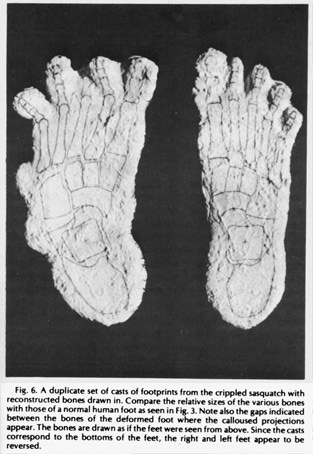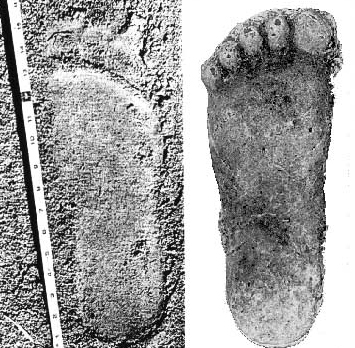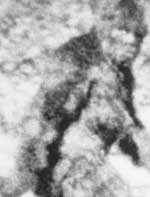What evidence is there to support the
existence of Sasquatch or Bigfoot?
By Michael Killen
 Along with the Patterson / Gimlin film
shot in 1967, there are other pieces of evidence that experts feel
would be very unlikely and extremely difficult to fake, and in these cases some
believe this evidence to be proof of their existence. One example of this
possible proof is the case of the mysterious Bossburg tracks (also known as the
“cripple foot” tracks) found near Bossburg, Washington in November and December
of 1969. The first series of tracks or trackway was found in the area around a
local garbage dump. Unfortunately, almost all of these first tracks were quickly
destroyed by a crowd of curious onlookers from the town. News of the amazing
discovery had been leaked in town and many people went out to the trackway to
see it for themselves before the evidence could be properly protected. The
second trackway found around Bossburg is one of the longest ever discovered and
features over 1,000 individual tracks allegedly left
by a passing Sasquatch with one club foot. Along with the Patterson / Gimlin film
shot in 1967, there are other pieces of evidence that experts feel
would be very unlikely and extremely difficult to fake, and in these cases some
believe this evidence to be proof of their existence. One example of this
possible proof is the case of the mysterious Bossburg tracks (also known as the
“cripple foot” tracks) found near Bossburg, Washington in November and December
of 1969. The first series of tracks or trackway was found in the area around a
local garbage dump. Unfortunately, almost all of these first tracks were quickly
destroyed by a crowd of curious onlookers from the town. News of the amazing
discovery had been leaked in town and many people went out to the trackway to
see it for themselves before the evidence could be properly protected. The
second trackway found around Bossburg is one of the longest ever discovered and
features over 1,000 individual tracks allegedly left
by a passing Sasquatch with one club foot.
.jpg) .jpg) |
|
The cast of a deformed
footprint impression from a crippled Sasquatch, or Bigfoot, from
Northeastern Washington State.
By studying the
difference between this print of a crippled foot in comparison to
the print from the normal foot, Dr. Krantz reconstructed the
skeletal structure. The deformed print shows a missing toe, bending
of the long axis of the foot, and two projections on the outside
edge of the sole. Note the gaps indicated between the bones of the
deformed foot where the calloused projections appear. Dr. Krantz
concluded that these deformities are consistent with the anatomy and
pathology expected of a crippled non-human, large-massed bipedal
animal, and that the precise correspondence of the crippled
pathology to the structure indicated by the non-deformed foot was
consistent with the physical adaptations necessary for bipedal
locomotion of a large-massed animal. Further, he stated that the
knowledge of physics, anatomy and bipedal locomotion that would be
needed for someone to fake that structure would be so specialized as
to make fakery unlikely. |
The normal, or
non-deformed footprint impression from a crippled Sasquatch, or
Bigfoot, from Northeastern Washington State, cast and reconstructed
by Dr. Grover Krantz, Professor of Anthropology at Washington State
University.
After
comparing this print to the deformed print, Dr. Krantz concluded
that the physical adaptations necessary to enable bipedal locomotion
for a very large animal were consistent with the structure indicated
by these feet. Namely, a flat foot, double ball, wide squarish heel,
shorter metatarsals and evenly spaced toes with impressions of even
pressure. Dr. Krantz concluded that the impressions were made by a
non-human foot of an animal consistent in size and shape with that
described in Bigfoot sightings. Due to the consistency of physical
adaptations with what would be needed for a large creature to move
in a bipedal manner, Dr. Krantz believed the prints nearly
impossible to fake.
For
more information about Dr. Krantz
CLICK HERE |
All of these tracks were completely anatomically correct for a creature the size and weight of a Sasquatch with the club foot deformity. These
tracks probably would have been very difficult to fake without a very good
understanding of primate anatomy and related bone structure, and the hoaxer
would have had to spend a lot of time and great effort to carefully create so
many perfectly formed “deformed” fake tracks. The late Dr. Grover Krantz, a
well-respected Washington State University anthropologist and initial Sasquatch
skeptic, considered these prints to be the undeniable proof that in the end
convinced him that Sasquatch did exist.
 Another famous set of alleged Sasquatch tracks involved two separate trackways
found at two different very remote locations, hundreds of miles apart from each
other in two different states. The first trackway was discovered 20 years before
the second one was found, and both trackways were an exact match, which left
only two possible explanations for this. They either had to have been made by
the same Sasquatch many years later in it’s travels through the wilderness or
else the alleged hoaxer had traveled hundreds of miles to place a second exactly
matching trackway in a very remote, hard-to-reach location 20 years after he
placed the first trackway. There is no way for the alleged hoaxer to know if his
fake tracks would have ever been discovered or if they would both eventually
have been compared by experts to confirm they were a match. To think that any
hoaxer would spend the time and have the skill to create two sets of exactly
matching trackways in two different and very remote locations in the hope that
someday they might both be discovered and compared is hard enough to believe.
But to suggest that the hoaxer would have the patience to wait a full 20 years
for his hoax to be completed is just completely unrealistic. The only
explanation that makes sense in this case is that they were both made by the
same Sasquatch many years apart and in completely different areas. Another famous set of alleged Sasquatch tracks involved two separate trackways
found at two different very remote locations, hundreds of miles apart from each
other in two different states. The first trackway was discovered 20 years before
the second one was found, and both trackways were an exact match, which left
only two possible explanations for this. They either had to have been made by
the same Sasquatch many years later in it’s travels through the wilderness or
else the alleged hoaxer had traveled hundreds of miles to place a second exactly
matching trackway in a very remote, hard-to-reach location 20 years after he
placed the first trackway. There is no way for the alleged hoaxer to know if his
fake tracks would have ever been discovered or if they would both eventually
have been compared by experts to confirm they were a match. To think that any
hoaxer would spend the time and have the skill to create two sets of exactly
matching trackways in two different and very remote locations in the hope that
someday they might both be discovered and compared is hard enough to believe.
But to suggest that the hoaxer would have the patience to wait a full 20 years
for his hoax to be completed is just completely unrealistic. The only
explanation that makes sense in this case is that they were both made by the
same Sasquatch many years apart and in completely different areas.
 Of course there are other solid pieces of evidence to support the existence of
these creatures besides the trackways. One very important piece of evidence for
the existence of Sasquatch are dermal ridges, which are basically fingerprints
found in some of the castings made from some well-formed tracks. Officer Jimmy
Chilcutt with the Conroe Police Dept in Texas certainly has the most experience
of anyone in North America, if not the world, at examining non-human primate
dermal ridges or fingerprints. Over the years he has fingerprinted many
different ape species and he has amassed a huge collection of about 1,000 of
these prints. His studies of the different skin patterns on the feet of the
different ape species have made him one of the world’s leading experts on the
subject of human and non-human primate dermal ridges. Originally a Sasquatch
skeptic, Chilcutt examined the collection of track casts of Dr. Jeff Meldrum,
associate professor of anatomy at Idaho State University. He eventually found
enough evidence to cause him to change his belief on the subject of Sasquatch;
he was now a firm believer. Of course there are other solid pieces of evidence to support the existence of
these creatures besides the trackways. One very important piece of evidence for
the existence of Sasquatch are dermal ridges, which are basically fingerprints
found in some of the castings made from some well-formed tracks. Officer Jimmy
Chilcutt with the Conroe Police Dept in Texas certainly has the most experience
of anyone in North America, if not the world, at examining non-human primate
dermal ridges or fingerprints. Over the years he has fingerprinted many
different ape species and he has amassed a huge collection of about 1,000 of
these prints. His studies of the different skin patterns on the feet of the
different ape species have made him one of the world’s leading experts on the
subject of human and non-human primate dermal ridges. Originally a Sasquatch
skeptic, Chilcutt examined the collection of track casts of Dr. Jeff Meldrum,
associate professor of anatomy at Idaho State University. He eventually found
enough evidence to cause him to change his belief on the subject of Sasquatch;
he was now a firm believer.
Another important piece of evidence is known as “The Skookum Cast”, a large
partial-body imprint discovered in September of 2000 in Washington State of an
alleged Sasquatch left in soft soil as it lay on the ground eating Apples from a
bait pile of fruit. The imprint seems to clearly show an impression of the
buttocks, thigh, ankle, forearm and even a partial heel impression complete with
possible dermal ridges of a Sasquatch made in the mud as it sat down and then
stretched over to grab the Apple from the pile of fruit. The casting was
examined by the late Dr. Grover Krantz, Dr. Jeff Meldrum and Dr. John Bindernagel
among others. They all agreed that this imprint was authentic, not made by any
known animal and not some type of hoax or fabrication.
Dr. Henner Fahrenbach’s studies of the dimensions of the alleged Sasquatch
footprints which were measured and compared over the last 40 years is another
very solid piece of evidence which seems to support the existence of Sasquatch.
Fahrenbach combined all of the data regarding total foot length, heel width and
ball width of the foot together on one paper showing it as a graph. When he
completed his graph of the combined data the shape on the paper formed a bell
curve. This bell curve is exactly what you would find when looking at various
shapes and sizes of the feet of a living population, whether they are human
beings or Sasquatch, as both of these species grow and age. His studies seem to
confirm that these footprints can’t all have been faked because of the wide
distribution of different sizes involved.
 Other evidence consists of various hair or scat samples and numerous vocal
recordings not found to match any known animal in North America. Not to mention
the fact that there is a long history of Sasquatch sightings by the Native
American tribes for over 400 years, long before any modern day pranksters were
ever born! Many of these tribes have carved Totem Poles with images of these
creatures. How could they possibly have known what Sasquatch looked like unless
they had seen them? Scientists know there have never been any known great apes
living in North America so the Native Americans couldn’t possibly have seen one,
yet they carved many images of an ape-like Sasquatch face on their Totem Poles.
This fact seems to indicate that they were well aware of the presence of
Sasquatch. Other evidence consists of various hair or scat samples and numerous vocal
recordings not found to match any known animal in North America. Not to mention
the fact that there is a long history of Sasquatch sightings by the Native
American tribes for over 400 years, long before any modern day pranksters were
ever born! Many of these tribes have carved Totem Poles with images of these
creatures. How could they possibly have known what Sasquatch looked like unless
they had seen them? Scientists know there have never been any known great apes
living in North America so the Native Americans couldn’t possibly have seen one,
yet they carved many images of an ape-like Sasquatch face on their Totem Poles.
This fact seems to indicate that they were well aware of the presence of
Sasquatch.
At this point in time, it would be easier to believe these creatures do in fact
exist than to believe that all the collected evidence has been nothing but a
series of elaborate hoaxes perfectly performed over the years by many different
people all working in concert together for the purposes of perpetuating a long
running hoax.
The photos appear here
under the fair use
for educational purposes of copyright material. |